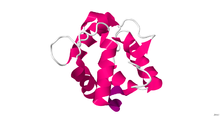パルブアルブミン
| parvalbumin | |
|---|---|
 PARVALBUMIN [1] | |
| 識別子 | |
| 略号 | PVALB |
| Entrez | 5816 |
| HUGO | 9704 |
| OMIM | 168890 |
| RefSeq | NM_002854 |
| UniProt | P20472 |
| 他のデータ | |
| 遺伝子座 | Chr. 22 q12-q13.1 |
パルブアルブミン(Parvalbumin)は、カルシウム結合性の低分子量のアルブミンである。
3つのEFハンドを持ち、構造的にはカルモジュリンやトロポニンCに近い。パルブアルブミンは速収縮筋に最も多く含まれ、脳や内分泌器にも含まれる。
パルブアルブミンは小型で安定なタンパク質で、EFハンド型のカルシウム結合部位を持ち、カルシウムシグナルに関与する。ドメインAB、CD、EFの3つに分かれ、それぞれがヘリックス-ループ-ヘリックスのモチーフを持っている[2]。ABドメインは2つのループ領域にアミノ酸欠損を持ち、CDドメインとEFドメインはそれぞれN末端とC末端を含んでいる[2]。パルブアルブミンのようなカルシウム結合タンパク質は、細胞周期調整やセカンドメッセンジャーの生産、筋肉収縮、微小管の形成等、多くの生理的過程において役割を果たす[1]。また、アルツハイマー病や神経疾患、加齢による認知障害やある種の癌等、様々な病気にも関わっている[2]。
パルブアルブミンは、神経系のGABA駆動性介在ニューロンに存在し、皮質のシャンデリア細胞や籠細胞では独占的に発現する。小脳ではプルキンエ細胞や分子層介在ニューロンで発現する[3]。海馬では、対象とする錐体細胞のドメインごとに細分されている[4]。脳波の中で、ガンマ波を発生させるとも考えられている。
サル目の背外側前頭前皮質では、GABA細胞の約25%がパルブアルブミンを発現する介在ニューロンである。他のカルシウム結合タンパク質は、カルレチニン(背外側前頭前皮質では50%)やカルビンディンである。介在ニューロン自体も発現する神経ペプチド(ソマトスタチン、ニューロペプチドY、コレシストキニン)によって分類される。
病気への関与
[編集]統合失調症患者のGABA駆動性介在ニューロンでは、パルブアルブミンとGAD67の発現量が減少しているのが発見されている[5]。またパルブアルブミンは魚アレルギーのアレルゲンとして同定されている[6]。
出典
[編集]- ^ a b Cates MS, Berry MB, Ho EL, Li Q, Potter JD, Phillips GN (October 1999). “Metal-ion affinity and specificity in EF-hand proteins: coordination geometry and domain plasticity in parvalbumin”. Structure 7 (10): 1269–78. PMID 10545326.
- ^ a b c Cates MS, Teodoro ML, Phillips GN (March 2002). “Molecular mechanisms of calcium and magnesium binding to parvalbumin”. Biophys. J. 82 (3): 1133–46. doi:10.1016/S0006-3495(02)75472-6. PMC 1301919. PMID 11867433.
- ^ Schwaller B, Meyer M, Schiffmann S (December 2002). “'New' functions for 'old' proteins: the role of the calcium-binding proteins calbindin D-28k, calretinin and parvalbumin, in cerebellar physiology. Studies with knockout mice”. Cerebellum 1 (4): 241–58. doi:10.1080/147342202320883551. PMID 12879963.
- ^ Klausberger T, Marton LF, O'Neill J, Huck JH, Dalezios Y, Fuentealba P, Suen WY, Papp E, Kaneko T, Watanabe M, Csicsvari J, Somogyi P (2005). “Complementary roles of cholecystokinin- and parvalbumin-expressing GABAergic neurons in hippocampal network oscillations”. J. Neurosci. 25 (42): 9782–93. doi:10.1523/JNEUROSCI.3269-05.2005. PMID 16237182.free full text
- ^ Hashimoto T, Volk DW, Eggan SM, Mirnics K, Pierri JN, Sun Z, Sampson AR, Lewis DA (2003). “Gene expression deficits in a subclass of GABA neurons in the prefrontal cortex of subjects with schizophrenia”. J. Neurosci. 23 (15): 6315–26. PMID 12867516. free full text
- ^ Swoboda I, Bugajska-Schretter A, Verdino P, Keller W, Sperr WR, Valent P, Valenta R, Spitzauer S (2002). “Recombinant carp parvalbumin, the major cross-reactive fish allergen: a tool for diagnosis and therapy of fish allergy”. J. Immunol. 168 (9): 4576–84. PMID 11971005.
外部リンク
[編集]- Parvalbumins - MeSH・アメリカ国立医学図書館・生命科学用語シソーラス
“Paramagnetism-based refinement strategy for the so... [Biochemistry. 2004 - PubMed result]”. 2010年6月1日閲覧。